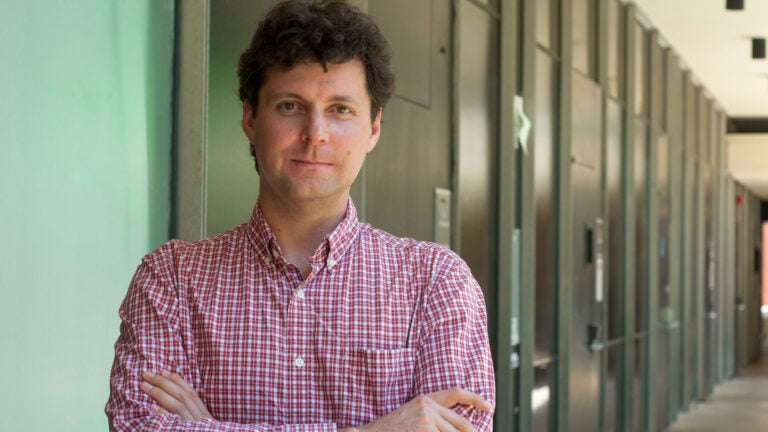
Paul Bogdan received a 2015 award from the National Science Foundation. (Photo/Daniel Druhora)
USC engineer looks at drugs that advance from bench to bedside
Paul Bogdan examines pharmaceuticals as if they were people who interact in a social network
USC’s Paul Bogdan focuses on drug repurposing — the discovery of new uses for approved pharmaceuticals to provide the quickest possible transition from bench to bedside.
In the fall of 2016, Nature published research on the subject by Bogdan, an assistant professor at the USC Viterbi School of Engineering, and an international team of scientists.
Bogdan, the 2015 National Science Foundation CAREER Award recipient, discusses the revelations and ramifications of his published work, which could pave a new path in his area of expertise.
What was the significance of this research?
Our work presents a systematic methodology based on big data and complex networks for linking drug interactions to pharmacological properties. In other words, we start with a big database of drug interactions to generate drug clusters which correspond to certain pharmacological properties such as immune system-related drugs. We have electronically verified the accuracy of our predictions by searching state-of-the-art literature that reports newly found drug properties.
We were amazed to find that 85 percent of our predicted properties are confirmed by the latest scientific discoveries in the fields of medicine, pharmacy and biology. To some extent, our effort contributes to bridging the gap between drug design — on the one hand — and social networks, social media — on the other.
What makes your research unique?
We are the first to analyze the drug-drug interaction networks with both modularity classes and force-directed network layouts. Normally, such techniques are used in social network analysis. Therefore, in a way, we are looking at drugs as if they were individuals who interact and interrelate in a social network.
Who will be directly impacted by your work and be likely to apply it?
I think that the first to use our work are those researchers looking for drug repositioning hints in order to perform in vitro and in vivo experiments for confirmation, thus leading to new therapies.
For instance, our methodology reveals a general relationship between cancer and epilepsy, based on peripheral overlapping of the two drug communities.
Moreover, our clustering technique uncovers new potential properties for 15 percent of analyzed drugs, so we expect that other confirmations will follow in the near future.
Why type of drugs did you analyze and how did do decide to look at them in particular?
All types of drugs that can be found in the DrugBank database. In all, we analyzed over 7,000 drugs, and a staggering 1,141 drugs were ultimately found to have unique drug-drug interactions. The only drugs we excluded are those which have no interactions because there was no way to connect them in a drug-drug interaction network. We can get a bird’s-eye view on the rendered drug-drug interactions communities only if we consider all drugs within the database. Also, we’re providing an intuitive, visual representation on drug interactions.
What finding did you find the most surprising?
Well, we were both surprised and amazed to see the extent of confirmation of our predicted drug repositionings. We are talking about the most recent experimental medical and pharmaceutical discoveries. Our supplementary material presents many such examples.
You’ve published twice in Nature. How difficult is it get something published in Nature?
The process is a very competitive since Nature is a highly ranked publication. The review stages can sometimes be laborious and demanding, but they can pose new interesting questions that can prompt the development of new research directions. You can appreciate this thorough review process only at the very end when the paper gets finalized and have thousands of new questions and tens of research directions.
Are you thinking of taking this research to the next level? What would that look like?
We plan to try to combine our methodology with other drug repurposing strategies, working from a structural perspective on drug-target interactions or chemical structure relationship networks. Such an endeavor will be extremely complex, so I think we will focus on specific disorders and diseases instead of using our current general approach that takes them all into consideration.
What are you working on now?
Right now, we are reading a lot of scholarly literature as we try to better relate our framework and ideas to complementary drug repositioning approaches.
We definitely do not feel satisfied. We are hungry for knowledge, now more than ever.
